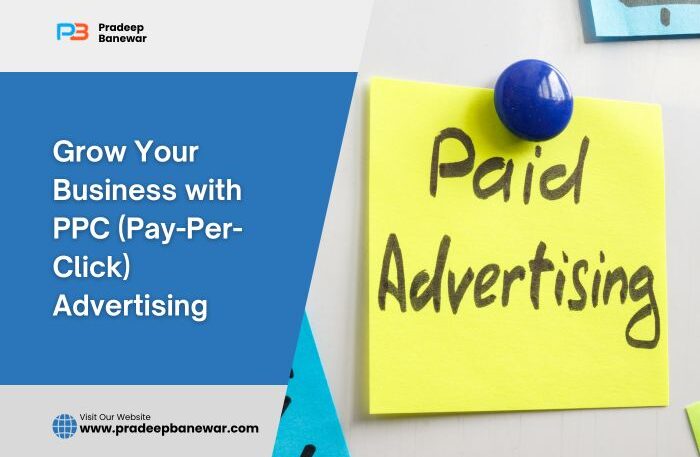Using paid advertising can be exciting and intimidating in the vast digital landscape where small businesses compete for visibility. Despite the apparent complexity of pay-per-click advertising for small businesses, this blog will shed light on the subject.
Let’s navigate the world of paid advertisements in simple words with clarity and usability.
The struggle to establish a distinctive online presence is evident for many small businesses. However, the introduction of paid advertising offers a glimmer of hope—a way to compete with more powerful rivals on an even playing field.
Small business owners looking for an approachable manual to expand their reach will find this discussion simple and easy to follow.
We’ll start with the basics, looking at why pay-per-click advertising is crucial for small business growth, and dispute the myths surrounding the various platforms. Together, we’ll figure out how to create ads that resonate with your audience, understand budgeting, and discover ways to measure success without becoming overwhelmed by analytics.
This blog is your road map for navigating the complex yet approachable world of paid advertising.
Understanding the Basics
Understanding the fundamentals of pay-per-click advertising is similar to building a solid foundation for the online expansion of your small business.
Paid advertising’s fundamental component is the promotion of your goods or services across numerous online platforms, putting your brand in front of prospective clients. Let’s simplify this idea without using any technical jargon to debunk it.
First and foremost, it’s essential to understand that pay-per-click advertising is not a universally effective strategy. Instead, it’s a flexible strategy that meets the particular requirements of your small business.
For those who might be confused by industry jargon, this will clarify the fundamental ideas behind paid advertising and explore them in detail.
Understanding the fundamentals of pay-per-click advertising is similar to building a solid foundation for the online expansion of your small business.
Paid advertising’s fundamental component is the promotion of your goods or services across numerous online platforms, putting your brand in front of prospective clients. Let’s simplify this idea without using any technical jargon to debunk it.
First and foremost, it’s essential to understand that pay-per-click advertising is not a universally effective strategy. Instead, it’s a flexible strategy that meets the particular requirements of your small business.
For those who might be confused by industry jargon, this will clarify the fundamental ideas behind paid advertising and explore them in detail.

We’ll delve into the fundamentals of paid advertisements while dispelling common myths and worries that frequently discourage small business owners.
By the end, you’ll understand why paid advertising isn’t a mysterious endeavor but a helpful and approachable tool for increasing your company’s visibility online.
To lay the foundation for a successful foray into the world of pay-per-click advertising, let’s set out on this journey to unravel the fundamentals.
Why Paid Advertising for Small Businesses?
Why should you embrace paid search advertising in the dynamic world of small businesses, where every penny counts? Small companies face particular difficulties, and paid advertising is a powerful ally in overcoming them.
Small companies frequently struggle with poor visibility in the vast digital landscape. Here, paid search advertising changes the game by bridging the gap between constrained budgets and lofty growth aspirations.
PPC advertising on websites like Google Ads and Facebook Ads, in contrast to more conventional methods, enables companies to precisely target audiences, maximizing the impact of every advertising dollar.
Additionally, paid advertising offers an expedited route to reach potential customers in the fiercely competitive digital space, where securing organic visibility can be difficult. It’s all about visibility and strategically placing your company in front of targeted customers.
We’ll explore the compelling arguments for paid advertising’s importance for small businesses, demystifying its role as a practical and economical way to level the playing field and spur growth.
Let’s investigate why PPC advertising for small businesses navigating the digital landscape is not just a strategic option but also a must-have.
Platforms and Options
Understanding the various platforms and options available to small businesses is essential for navigating the vast world of paid advertising.
This blog post will explore some of the most well-known platforms to demystify their functions and suitability for companies.
Google Ads, a dominant digital advertising platform, enables companies to dominate search engine results, grabbing the interest of users actively looking for related goods or services.
We’ll explain how to create text or display ads, making Google Ads a viable starting point for side projects.
On the other hand, Facebook Ads benefits from the social connectivity of its over 2.8 billion monthly users. Here, we’ll look at using the platform’s sophisticated targeting features to create visually appealing ads that connect with target audiences.
Instagram has become a powerhouse for companies with compelling visual narratives. We’ll delve into Instagram Ads’ aesthetics to captivate audiences by utilizing the visual appeal of the platform.
Understand the specifics of each platform to customize your paid advertising strategy. I
t is your guide to navigating the diverse landscape of paid search advertising platforms, aiding you in making decisions that align with your small business objectives, whether it be the intent-driven searches on Google or the social engagement on Facebook and Instagram.
Tailoring Ads for Your Audience
Beyond the platforms, creating effective paid advertising requires a thorough understanding of your audience. We’ll explain how to craft ads that speak to your audience’s interests and wants.
Understanding your audience’s preferences is essential for effective advertising. We look at how to produce content that draws in viewers and forges connections.
We explore the subtleties of crafting messages that resonate, from understanding your audience’s language to identifying the issues they seek solutions to.
Visual appeal is essential, as consumers prefer to scroll through digital content quickly. We’ll talk about how important it is to have a clear copy that is easy to read and understand and compelling images that help people remember what you’re saying.
In addition, with the rise of personalized marketing, we investigate how customization can take your ads from impersonal sales pitches to distinctive experiences.
In this blog post, you gain the knowledge necessary to create ads that attract attention and convert, capable of reaching local clients or a global audience.
By the end, you’ll be skilled at identifying the pulse of your audience and integrating that knowledge into each component of your paid advertising strategy.
Budgeting Tips for Small Businesses
Making wise financial decisions is essential for small businesses when navigating the world of paid advertising.
Here, we debunk the process and provide helpful advice to ensure that every advertising dollar is an investment in development.
Small businesses frequently operate within limited financial constraints, so wise budgeting is essential. We delve into the art of creating reasonable budgets that match your company’s objectives and resources.
When using platforms like Google Ads, understanding the cost-per-click (CPC) dynamics and the bidding procedures becomes essential for businesses to optimize their spending.
Another essential component of efficient budgeting is testing. Our discussion of the value of A/B testing will help you fine-tune your strategy and allocate your budget to the most efficient ads and targeting options.
Iterative testing focuses on the most economical methods while maximizing the campaign’s impact.

We cover modifying your budget based on performance indicators. Importantly.
It gives small business owners the tools to navigate the dynamic world of paid advertising while keeping a close eye on the bottom line, whether adjusting bids, reallocating funds to high-performing campaigns, or pausing underperforming ones.
By the end, you’ll be skilled at budgeting for the best outcomes in digital advertising.
Measuring Success
It’s essential to comprehend the results of your paid advertising efforts as it is to develop effective campaigns.
In this, we examine useful metrics for success without getting bogged down in technical analytics speak, giving small business owners understandable information.
Using key performance indicators (KPIs) is the cornerstone of success. We provide a clear understanding of how to assess the effectiveness of your campaigns by deconstructing simple metrics like click-through rates, conversion rates, and return on ad spend.
We emphasize these metrics’ ease of use and how they support more general business goals.
Tracking success entails more than just numbers; it also entails comprehending consumer behavior. We examine the significance of customer interactions, qualitative feedback, and social media engagement as crucial campaign resonance indicators.
Examples from the real world show how these insights help businesses optimize their strategies.
The objective is to give small business owners the power to make decisions based on verifiable outcomes.
By the end, you’ll understand the crucial metrics and recognize the value of an agile strategy that allows you to adapt your campaigns based on actual performance to achieve long-term success in paid advertising.
Overcoming Common Challenges
Challenges are unavoidable in the paid advertising journey for small businesses, but they don’t have to be insurmountable barriers. It offers a road map for businesses to avoid potential pitfalls as we address common obstacles with practical solutions.
Ad fatigue, in which the audience becomes desensitized to repetitive content, is one persistent problem. We look at original ways to keep your messaging current, such as dynamic ad formats and sporadic updates to keep audiences interested.
For small businesses, financial restrictions frequently loom large. It explores creative approaches to maximizing impact without going bankrupt, highlighting the significance of wise allocation and concentrating resources on high-return activities.
It can be challenging to adjust to the constantly evolving digital landscape. We talk about how important it is to keep up with platform updates, algorithm changes, and new trends. Small businesses can benefit from new opportunities while also remaining relevant by doing this.

We then discuss the issue of scalability. Small businesses might be concerned about keeping marketing campaigns effective as they expand. Growth shouldn’t erode the effectiveness of your advertising efforts, thanks to practical knowledge of scaling strategies and the use of automation tools.
This hands-on manual provides practical solutions to everyday problems so that small businesses can successfully negotiate the complexities of paid advertising.
Frequently Asked Questions (FAQs)
1. What is paid advertisement?
Paid advertisement is a promotional strategy where businesses or individuals pay a fee to display their content, products, or services to a target audience through various media channels.
2. What is a paid media advertising example?
A paid media advertising example is a sponsored post on social media platforms like Facebook or Instagram, where businesses pay to display their content to a specific audience.
3. What are the elements of paid ads?
Paid ads typically consist of ad copy (text), creative visuals (images or videos), targeting parameters (demographics, interests), and a call-to-action (CTA) to encourage user engagement.
4. What type of ad is best?
The best type of ad depends on the specific goals, target audience, and platform. Search engine ads, display ads, video ads, social media ads, and native ads are different types that serve specific purposes based on the campaign’s objectives.
Paid advertising appears not as a mysterious maze but as a helpful compass for small business expansion. This manual has demystified the procedure with a conversational touch, covering everything from comprehending the fundamentals to tailoring ads for a particular audience, navigating platforms, and overcoming difficulties.
The journey through paid search advertising is framed as an accessible way to increase visibility and compete in the digital sphere, emphasizing measurable success without becoming bogged down in analytics.
Small businesses are well-positioned to benefit from pay-per-click advertising as a dynamic tool for scalable success in today’s competitive landscape because they have budgeting insights and strategies to avoid common pitfalls.





